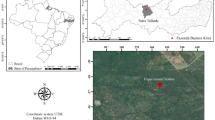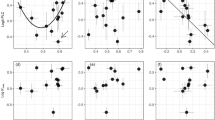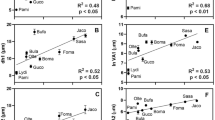Abstract
The objective of the present study was to examine the functional coordination among hydraulic traits, xylem characteristics and gas exchange rates across three deciduous Euphorbiaceae tree species (Hevea brasiliensis, Macaranga denticulata and Bischofia javanica) and three evergreen Euphorbiaceae tree species (Drypetes indica, Aleurites moluccana and Codiaeum variegatum) from a seasonally tropical forest in south-western China. The deciduous tree species were more vulnerable to water stress-induced embolism than the evergreen tree species. However, the deciduous tree species generally had higher maximal rates of sapwood and leaf-specific hydraulic conductivity (K S and K L), respectively. Compared with the evergreen tree species, the deciduous tree species, however, possessed a lower density of sapwood and a wider diameter of xylem vessels. Regardless of leaf phenology, the hydraulic vulnerability and conductivity were significantly correlated with sapwood density and mean vessel diameter. Furthermore, the hydraulic vulnerability was positively correlated with water transport efficiency. In addition, the deciduous tree species exhibited higher maximal photosynthetic rates (A max) and stomatal conductance (g max), but lower water use efficiency (WUE). Interestingly, the A max, g max and WUE were strongly correlated with K S and K L across the deciduous and evergreen tree species. These results suggest that xylem structure, rather than leaf phenology, accounts for the difference in hydraulic traits between the deciduous tree species and the evergreen tree species. Meanwhile, our results show that there is a significant trade-off between hydraulic efficiency and safety, and a strong functional correlation between the hydraulic capacity and gas exchange rates across the deciduous and evergreen tree species.






Similar content being viewed by others
References
Brodribb TJ, Field TS (2000) Stem hydraulic supply is linked to leaf photosynthetic capacity: evidence from new Caledonian and Tasmanian rainforest. Plant Cell Environ 23:1381–1388
Brodribb TJ, Holbrook NM, Gutiérrez MV (2002) Hydraulic and photosynthetic co-ordination in seasonally dry tropical forest trees. Plant Cell Environ 25:1435–1444
Brodribb TJ, Holbrook NM, Edwards EJ, Gutiérrez MV (2003) Relations between stomatal closure, leaf turgor and xylem vulnerability in eight tropical dry forest trees. Plant Cell Environ 26:443–450
Bucci SJ, Goldstein G, Meinzer FC, Scholz FG, Franco AC, Bustamante M (2004) Functional convergence in hydraulic architecture and water relations of tropical savanna trees: from leaf to whole plant. Tree Physiol 24:891–899
Choat B, Ball M, Luly J, Holtum J (2003) Pit membrane porosity and water stress-induced cavitation in four co-existing dry rainforest tree species. Plant Physiol 131:41–48
Choat B, Ball MC, Luly JG, Holtum JAM (2005) Hydraulic architecture of deciduous and evergreen dry rainforest tree species from north-eastern Australia. Trees 19:305–311
Choat B, Sack L, Holbrook NM (2007) Diversity of hydraulic traits in nine Cordia species growing in tropical forests with contrasting precipitation. New Phytol 175:686–698
Cornelissen JHC, Castro Diez P, Hunt R (1996) Seedling growth, allocation and leaf attributes in a wide range of woody plant species and types. J Ecol 84:755–765
Domec JC, Gartner BL (2001) Cavitation and water storage capacity in bole xylem segments of mature and young Douglas-fir trees. Trees 15:204–214
Domec JC, Gartner BL (2002) Age- and position-related changes in hydraulic versus mechanical dysfunction of xylem: inferring the design criteria for Douglas-fir wood structure. Tree Physiol 22:91–104
Gartner BL (1995) Patterns of xylem variation within a tree and their hydraulic and mechanical consequences. In: Gartner BL (eds) Plant stems: physiology and functional morphology. Academic Press, New York, pp 125–149
Gartner BL, Meinzer FC (2005) Structure–function relationships in sapwood water transport and storage. In: Holbrook NM, Zwieniecki MA (eds) Vascular transport in plants. Elsevier, Boston, pp 307–331
Gartner BL, Bullock SH, Mooney HA, Brown VB, Whitbeck JL (1990) Water transport properties of vine and tree stems in a tropical deciduous forest. Am J Bot 77:742–749
Goldstein G, Rada F, Rundel P, Azocar A, Orozco A (1989) Gas exchange and water relations of evergreen and deciduous tropical savanna trees. Ann Sci For 46:448–453
Hacke UG, Sperry JS, Pockman WT, Davis SD, McCulloh KA (2001) Trends in wood density and structure are linked to prevention of xylem implosion by negative pressure. Oecologia 126:457–461
Hao G-Y, Hoffmann WA, Scholz FG, Bucci SJ, Meinzer FC, Franco AC, Cao K-F, Goldstein G (2008) Stem and leaf hydraulics of congeneric tree species from adjacent tropical savanna and forest ecosystems. Oecologia 10.1007/s00442-007-0918-5
Holbrook NM, Whitbeck JL, Mooney HA (1995) Drought responses of neotropical dry forest trees. In: Bullock SH, Mooney HA, Medina E (eds) Seasonally dry tropical forests. Cambridge University Press, Cambridge, pp 243–270
Hubbard RM, Ryan MG, Stiller V, Sperry JS (2001) Stomatal conductance and photosynthesis vary linearly with plant hydraulic conductance in ponderosa pine. Plant Cell Environ 24:113–121
Katul G, Leuning R, Oren R (2003) Relationship between plant hydraulic and biochemical properties derived from a steady-state coupled water and carbon transport model. Plant Cell Environ 26:339–350
Kavanagh KL, Bond BJ, Aitken SN, Gartner BL, Knowe S (1999) Shoot and root vulnerability to xylem cavitation in four populations of Douglas-fir seedlings. Tree Physiol 19:31–37
Maherali H, Pockman WT, Jackson RB (2004) Adaptive variation in the vulnerability of woody plants to xylem cavitation. Ecology 85:2184–2199
Maherali H, Moura CF, Caldeira MC, Willson CJ, Jackson RB (2006) Functional coordination between leaf gas exchange and vulnerability to xylem cavitation in temperate forest trees. Plant Cell Environ 29:571–583
Meinzer FC (2002) Co-ordination of vapour and liquid phase water transport properties in plants. Plant Cell Environ 25:265–274
Meinzer FC (2003) Functional convergence in plant responses to the environment. Oecologia 134:1–11
Meinzer FC, Clearwater MJ, Goldstein G (2001) Water transport in trees: current perspectives, new insights and some controversies. Environ Exp Bot 45:239–262
Pammenter NW, Vander Willigen C (1998) A mathematical and statistical analysis of the curves illustrating vulnerability of xylem to cavitation. Tree Physiol 18:589–593
Piňol J, Sala A (2000) Ecological implications of xylem cavitation for several Pinaceae in the Pacific Northern USA. Funct Ecol 14:538–545
Reich PB, Walters MB, Ellsworth DS (1992) Leaf life-span in relation to leaf, plant, and stand characteristics among diverse ecosystems. Ecol Monogr 62:365–392
Rosner S, Klein A, Wimmer R, Karlsson B (2006) Extraction of features from ultrasound acoustic emissions: a tool to assess the hydraulic vulnerability of Norway spruce trunkwood? New Phytol 171:105–116
Rosner S, Klein A, Müller U, Karlsson B (2007) Hydraulic and mechanical properties of young Norway spruce clones related to growth and wood structure. Tree Physiol 27:1165–1178
Santiago LS, Goldstein G, Meinzer FC, Fisher JB, Machado K, Woodruff D, Jones T (2004) Leaf photosynthetic traits scale with hydraulic conductivity and wood density in Panamanian forest canopy trees. Oecologia 140:543–550
Sobrado MA (1993) Trade-off between water transport efficiency and leaf life-span in a tropical dry forest. Oecologia 96:19–23
Sobrado MA (1997) Embolism vulnerability in drought-deciduous and evergreen species of a tropical dry forest. Acta Oecol 18:383–391
Sparks JP, Black A (1999) Regulation of water loss in populations of Populus trichocarpa: the role of stomatal control in preventing xylem cavitation. Tree Physiol 19:453–459
Sperry JS, Saliendra NZ (1994) Intra-plant and inter-plant variation in xylem cavitation in Betula occidentalis. Plant Cell Environ 17:1233–1241
Sperry JS, Tyree MT (1988) Mechanism of water stress-induced xylem embolism. Plant Physiol 88:581–587
Villar R, Held AA, Merino J (1995) Dark leaf respiration in light and darkness of an evergreen and a deciduous plant species. Plant Physiol 107:421–427
Webb WL, Newton M, Starr D (1974) Carbon dioxide exchange of Alnus rubra: a mathematical model. Oecologia 17:281–291
Zimmermann MH (1983) Xylem structure and the ascent of sap. Springer, New York
Acknowledgments
This study was funded by the National Science Foundation of China (project no. 90302013). The authors thank Zhi-Hui Liu, Xue-Wei Fu, Jin-Yu Liu and Hong Ma for their experimental assistance. The authors also thank Guang-You Hao and Pei-Li Fu for their helpful comments on the manuscript.
Author information
Authors and Affiliations
Corresponding author
About this article
Cite this article
Chen, JW., Zhang, Q. & Cao, KF. Inter-species variation of photosynthetic and xylem hydraulic traits in the deciduous and evergreen Euphorbiaceae tree species from a seasonally tropical forest in south-western China. Ecol Res 24, 65–73 (2009). https://doi.org/10.1007/s11284-008-0482-4
Received:
Accepted:
Published:
Issue Date:
DOI: https://doi.org/10.1007/s11284-008-0482-4




